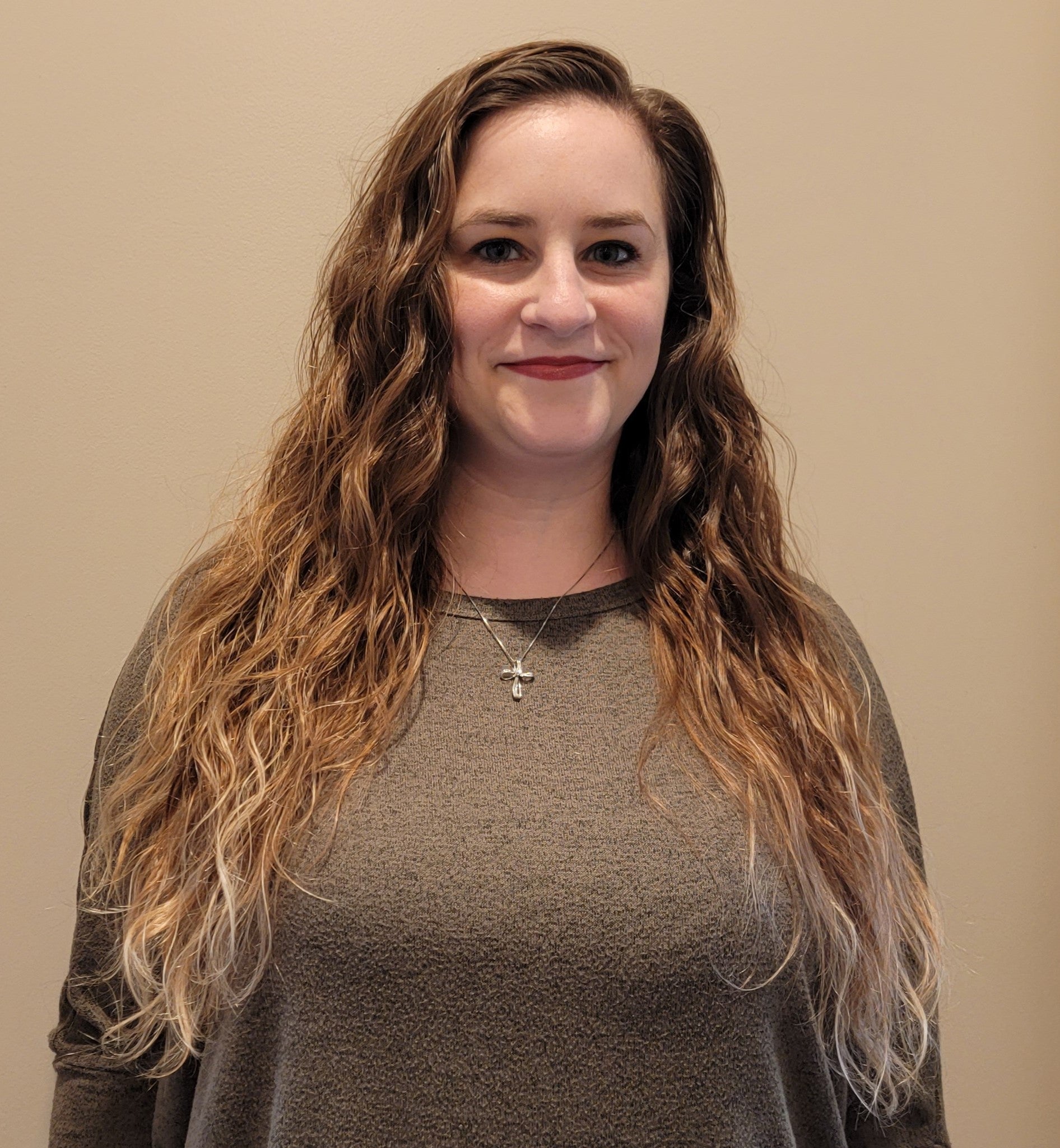A Headache Like No Other
April 30, 2023
By: Val Enti
Categories: Neurosciences (Brain Spine, Nerves)
Tags: Stroke, Stroke care, stroke patient
Amber Crawford, 34, has been dealing with migraines for more than 10 years. She doesn’t go to the Emergency Department (ED) for her migraines because she has her “bag of tricks” she uses to ease the pain. But late at night on Feb. 1, Amber had a migraine that was very different. “I felt like my head was going to split in half right down the middle,” said Amber.
In the 24 hours that followed, Amber and her fiancé, Eric, visited the ED twice looking for relief. Both times, the medical staff checked Amber’s bloodwork and vitals, which were normal. Her neurological examination did not show any signs of stroke. Amber was discharged both times with medication for the pain, but the pain persisted.
On her second visit to the ED, the physician decided to monitor her for several hours before discharging her.
“The doctor warned Eric that I would be drowsy and that if my speech changed or anything out of the norm happened, to bring me back,” Amber said.
Taking the physician’s words seriously, Eric brought Amber home and kept an eye on her.
Clear Signs of Something Wrong
Three hours later, Amber’s mom happened to visit and after looking at Amber, she asked why Amber was wearing her underwear over her leggings. “To keep warm,” Amber replied.
Shortly thereafter, Amber stopped talking and responding to questions. Her eyes were dilated, and she was also doing something strange with her hands — similar to what her fiancé’s grandfather had done when he was having a stroke. That’s when Eric called 911. After that, Amber remembers nothing.
 Back at the ED, the team performed a CT scan and immediately placed Amber in a medically induced coma and on a ventilator. She was transferred to the ED at Trinity Health Grand Rapids where the vascular neurology team from Trinity Health Hauenstein Neuroscience Center sprang into action under the direction of Muhammad Farooq, MD, medical director of Vascular Neurology and Neurohospitalist Section (pictured right).
Back at the ED, the team performed a CT scan and immediately placed Amber in a medically induced coma and on a ventilator. She was transferred to the ED at Trinity Health Grand Rapids where the vascular neurology team from Trinity Health Hauenstein Neuroscience Center sprang into action under the direction of Muhammad Farooq, MD, medical director of Vascular Neurology and Neurohospitalist Section (pictured right).
Neurointerventional Radiologist Baljit Deol, MD, director of Neurointerventional Services at Trinity Health Grand Rapids, also consulted on the case.
The Diagnosis: A Rare Type of Stroke
The neurology team performed a number of diagnostic tests, including a CT angiogram of the brain, computed tomography (CT) scan of the brain, blood tests, and other tests.
“The diagnostic workup by Dr. Farooq and his vascular neurology team was phenomenal,” said Dr. Deol.
Amber was diagnosed with a rare form of stroke that affects five in a million people each year: cerebral venous sinus thrombosis (CVST). It is most common among young people and women of childbearing age.
“CVST occurs when a blood clot forms in the brain’s venous sinuses, preventing blood from draining out of the brain. As a result, blood cells leak into the brain tissues, forming a hemorrhage called venous stroke. When caught early, the prognosis can be good,” said Dr. Farooq.
 Fixing the Problem
Fixing the Problem
On Feb. 2, Dr. Deol performed an intercranial dural venous sinus thrombolysis on Amber.
“In layperson’s terms, it involves injecting medicine into the clot to soften it. The next day, I performed a thrombectomy, a minimally invasive procedure in which I placed a catheter in the brain and removed the clot in the dural sinuses,” said Dr. Deol (pictured right).
Stroke patient outcomes are impressive due to Trinity Health’s state of the art technology combined with compassionate experts who put their patients first.
The Aftermath
Now months later, Amber takes two medications following her stroke: one is a blood thinner and the other controls her heart rate.
“I definitely feel tired and weak. I have no muscle. I also have numbness, but it doesn’t interfere with the function of my body,” said Amber. Her speech and cognition appear to have no deficits.
About 80% of CVST patients make a full independent recovery if they are treated in a timely fashion. About 25% of patients experience long-term deficits.
Recently, Amber finished occupational therapy and will continue speech therapy and physical therapy to ensure that she has the best opportunity to fully recover.
“Overall, Amber is doing very well and has almost no deficits. Her prognosis is very good. We call this a miracle,” said Dr. Farooq. “We are lucky to have such an amazing stroke team, Emergency Department, and Intensive Care Unit.”
Amber’s Risk Factors for CVST
Thankfully, a few weeks before her stroke, Amber’s Primary Care physician placed her on blood pressure medication for recently detected high blood pressure.
Amber had also been taking oral contraceptives since age 16. In her early 20s, the medication was changed to address her endometriosis. Oral contraceptives are a risk factor for CVST because they tend to promote blood clotting.
Testing also revealed that Amber has a genetic mutation — “factor V Leiden,” which is one of the clotting factors in the blood. This mutation can increase a woman’s chance of developing abnormal blood clots that can block blood vessels and be life-threatening, especially when combined with taking the hormone estrogen.
Amber’s Care at Trinity Health
Amber spent a total of 20 days in hospital. The first seven days she was on a ventilator. Her first recollection of being in the hospital came four days after she was taken off the ventilator.
Her first recollection is that of a nurse telling her where she was and that she had a stroke. “We joke a lot in our family, and at the time, I was waiting for someone to say that the nurse was joking. It took a little time for me to accept that what the nurse had said was true,” Amber shared.
‘Gratitude’ is how Amber describes her feelings about the staff at Trinity Health. “Everyone was amazing. Everyone was so kind. I have no complaints.”
She also thanks God for keeping her alive. “I don’t know why God saved me. I hope my experience will help save someone else. I guess I’m not done yet. There is more for me to do in this world.”
Amber’s parting advice is this: “If you are having a ‘different kind of migraine,’ let someone know, so they can keep an eye on you as Eric did for me. That made all the difference.”
Learn more about Trinity Health’s Stroke and Cerebrovascular Disease programs.
Read how Trinity Health’s award-winning stroke care saved a patient who suffered a stroke while driving.
Read about the causes and signs of stroke.
Read how to prevent stroke.
Read about today’s stroke treatments.
Statistical Sources and Definitions:
Cerebral Venous Sinus Thrombosis (CVST) | Johns Hopkins Medicine
Clinical Profile and Prognosis of Cerebral Venous Sinus Thrombosis - PMC (nih.gov)



